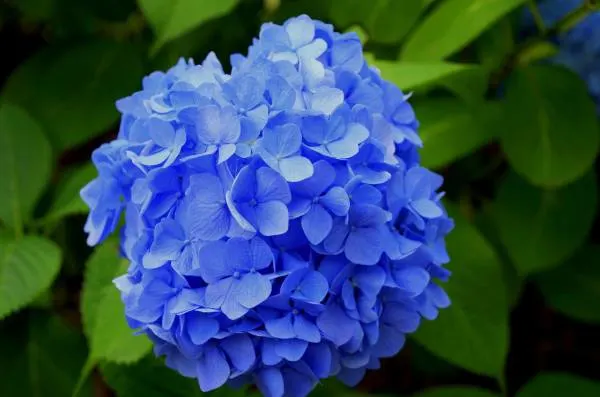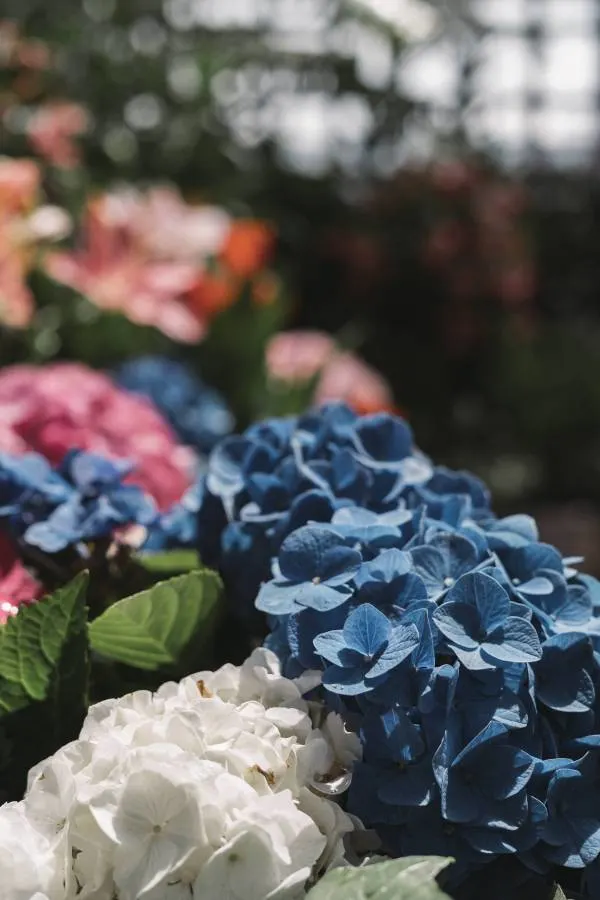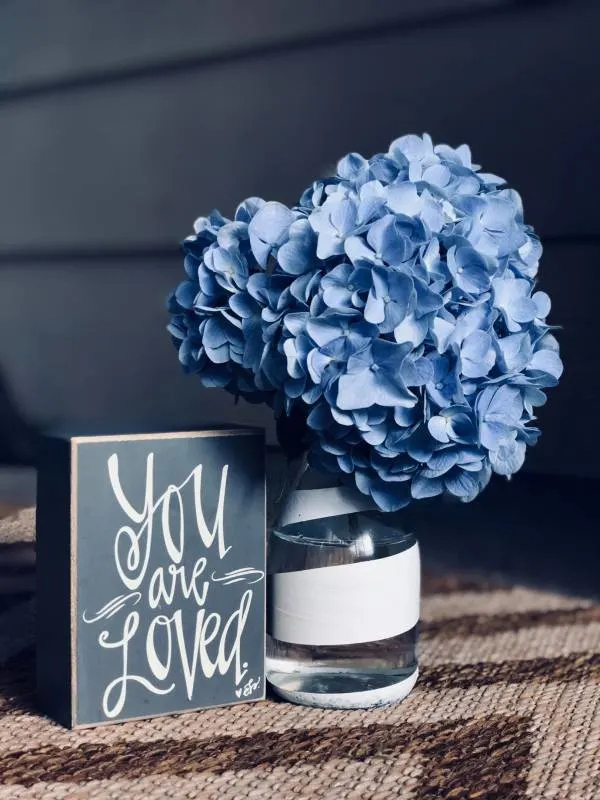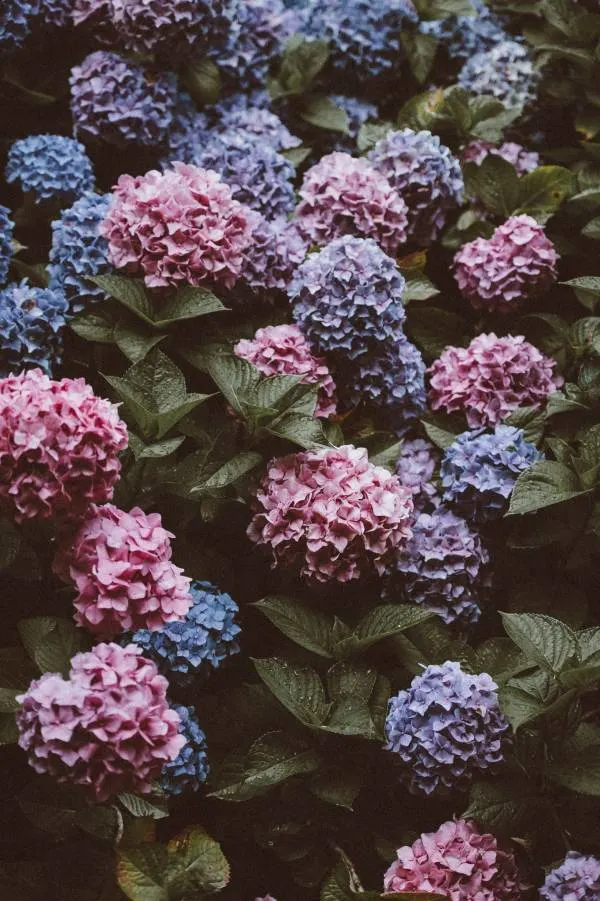Imagine stepping into a garden adorned with an enchanting display of beautiful blue hydrangeas.
Their vibrant blooms dance in harmony with a gentle breeze. It is a sight that fills the heart with awe and wonder.
Isn’t it?
While hydrangea flowers naturally exhibit a captivating range of hues, the blue blooms often steal attention.
But maintaining the vibrant hue of blue hydrangea flowers can be a challenging task.
For this reason, it leaves many gardeners scratching their heads, thinking what makes the hydrangeas turn blue, and how to keep them shining with their deep blue colored blooms.
Worry not!
The key to mastering the art of keeping your hydrangea blue lies within these pages.
So, get ready to transform your garden into a unique art, and let’s explore the secrets of achieving the alluring blue tones of hydrangea bushes!

The Art of Keeping Hydrangeas Blue!
When it comes to hydrangea’s flowers, color plays a significant role in their attraction.
The delicate beauty of blue hydrangeas brings a sense of peace and charm to any garden or floral display.
Therefore, those who wish to display these fascinating blooms, aim to achieve and maintain the blue hue they desire.
So, without further ado, let’s discuss some simple steps for keeping these beautiful blue blooms!
1. Start with the Right Species
If you want to see some blue hydrangeas grow in your garden this season, it is best to start with the right species.
As it is said,
“Sow thin and mow thin.”
The reason is that not all types of hydrangeas produce blue blossoms.
Therefore, if you pick the wrong variety, you won’t get your loving blue hydrangeas.
That might be a new thing you hear, but it is true that hydrangea colors depend upon the variety of plant you are growing in your garden.
There are six common species of hydrangea that possesses their own unique beauty and appearance.
But sadly, only two of them offer blue flowers, including:
Hydrangea macrophylla
Hydrangea serrata
Within these same plant species, there are many different blue varieties.
Pro Tip: While choosing a hydrangea variety, look for those labeled as “blue” or “color-changing” to increase your chances of obtaining vibrant blue hydrangea blooms or the ones that turn hydrangeas blue.

2. Plant in the Right Location
While choosing the right location for your hydrangeas, you have to look for certain things.
Let’s start with the soil type.
Hydrangeas do best in soil that retains moisture without becoming waterlogged. Therefore, well-drained soil is crucial because it prevents excess water from escaping, preventing root rot and other water-related issues.
To prepare the soil for hydrangeas, consider the soil’s pH level, its composition, and provide the necessary organic matter.
Organic matter plays a crucial role in soil fertility and structure.
Adding compost, well-rotted manure, or peat moss can improve:
Soil structure
Moisture retention
Nutrient availability
Apart from that, avoid planting your hydrangeas near the concrete structure. Because concrete may leach some compounds into the soil, making it alkaline.
Although alkaline soil or neutral soil is not harmful to the hydrangeas, it is an enemy of your desires. Because alkaline or sweet soil won’t let the hydrangea maintain its blue color. Therefore, you would need to maintain acidic soils.
Both of the blue varieties of hydrangea can thrive in partial shade and so prefer about 4-5 hours of sunlight daily.
Keeping all these considerations in mind, look for the perfect spot for your hydrangeas.
3. Test Your Soil pH Levels
When you find the perfect spot for your hydrangeas, it is advisable to test your soil’s pH before planting.
But why is it essential?
The pH level affects the availability of certain compounds and nutrients in the soil, which directly affects the pigments responsible for hydrangea color.
Maintaining an acidic soil with a pH level of about 5.5 is crucial for blue bloom color as it lets the plant absorb aluminum, giving it blue hues.
On the other hand, alkaline soil conditions inhibit aluminum uptake and lead to pink flowers or purple hydrangea blooms.
By conducting a soil test, you can monitor and maintain the and test your soil’s acidity. You can test your soil pH level with a store-bought kit from your local hardware or garden-supply store.
4. Adjust the Soil’s pH
After you’ve tested your soil’s pH level and you find that your soil is already acidic, then you are ready to start because your soil is already perfect for hydrangeas.
But if your soil is alkaline, you have to work on making the soil acidic.
To lower the soil’s pH for blue hydrangea blooms, several methods can be employed.
The primary approach is to add soil amendments that increase soil acidity.
Two commonly used amendments for lowering soil’s pH are aluminum sulfate and sulfur.
1. Adding Aluminum Sulfate
Aluminum sulfate is a readily available soil adjustment that helps lower soil pH.
When applied correctly, it provides a source of aluminum, enabling the hydrangea plants to uptake aluminum and produce blue flowers.
Follow the manufacturer’s instructions for application rates, as excessive amounts of alum can damage plants or lead to nutrient imbalances.
Generally, a recommended rate is one tablespoon per gallon of water.
Growgardener’s Note: It is essential to distribute the mixture evenly and avoid contact with the plant’s foliage to prevent burning.
2. Applying Sulfur
Elemental sulfur is another effective soil adjustment substance for lowering the pH of the soil.
Elemental sulfur is commonly used and works by gradually converting to sulfuric acid through microbial activity in the soil.
This acidification process reduces soil pH over time.
The recommended application rate of sulfur depends on the current soil pH and desired reduction.
NOTE: It is important to note that sulfur takes time to have an effect, so adjustments to pH should be made well before the growing season.
5. Keep Them Watered
Like other parts of the plants, blue color blooms can become dehydrated and begin to wilt and, as usual, turn brown.
So, keeping the hydrangeas well-watered will help them in many ways.
Water your hydrangeas deeply and thoroughly to encourage deep root growth.
New plantings may need to be watered every day, especially during the warm weather, but the established plant may only need to be watered once or twice per week.
However, the actual watering frequency and amount may vary depending on factors such as:
Weather conditions
Soil type
Plant size
Monitor the soil moisture level and adjust the watering schedule to prevent water stress or overwatering because hydrangeas are susceptible to both.
Hydrangeas in Container!
Changing or keeping the color of hydrangeas in containers is much easier than in the ground.
The reason is that controlling the soil pH in a container is simpler than doing so in the ground. And because the soil is looser in a container than in the garden, applying the soil acidifier is much easier.
Now let me tell you how to keep your own hydrangea color blue in the container.
You must start by following the same steps as discussed before, but you won’t need a soil test in the container.
Getting my point?
Use potting soil specifically for acid-loving plants; otherwise, you can also use a soil acidifier.
Pro Tip: One thing to remember while growing and keeping hydrangea blue in the container is that they need more frequent watering.

FAQs!
Here are the answers to some frequently asked questions.
How Long Does It Take for Hydrangeas to Change Color After Adjusting the Soil pH?
The time it takes for hydrangeas to change color after adjusting the soil pH can vary.
You may start seeing gradual color changes in hydrangea flowers within a few weeks to a couple of months.
However, the complete transformation can take a full growing season.
How Can I Protect My Blue Hydrangeas from Extreme Weather Conditions?
To protect your blue hydrangeas from extreme weather, take these measures:
Mulch around the plants to insulate roots from temperature fluctuations.
Cover with burlap or a frost cloth during winter.
Plant hydrangeas where you can shield them from strong winds to prevent damage.
Related Article: Why Is My Hydrangea Dying? How Can I Save It?
Can I Change the Color of My Pink Hydrangeas to Blue?
Yes, it is possible to change pink hydrangea flowers to blue.
The pink color of hydrangea blooms is also influenced by soil pH.
To shift hydrangeas pink color to blue, you’ll need to lower the soil pH to make it more acidic.

You can change the color of your pink hydrangeas by using specific soil amendments, such as aluminum sulfate or sulfur.
Note: You can only change pink hydrangea to blue if you have chosen the color-changing specie. Otherwise, your pink hydrangea plant won’t produce your desired flowers.
Related Article: Why Are My Hydrangeas Turning Green? | 4 Causes!
That’s all for today!
Now it’s time to move toward the conclusion and summarize the talk here.
Conclusion!
So, how to keep your hydrangea blue? I hope you got your answer.
To keep your hydrangea blue, you have to start with the right specie. There are six common species of hydrangea, out of which only two produce blue blossoms.
Apart from that, the blue tone of hydrangea is maintained in acid soil because acidic soil leads to the uptake of aluminum, which gives the plant a blue tone.
So, adjust the soil pH before planting hydrangea, as it helps keep your plant blue.
You can use aluminum sulfate or simply sulfur in this regard.
If you want to grow and maintain blue hydrangeas in a container, it might be an easier option for you (as mentioned before).
So, let’s start and paint your garden with beautiful shades of blue!
Best wishes,
Moiz Atiq.
